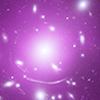CXC Home | Search | Help | Image Use Policy | Latest Images | Privacy | Accessibility | Glossary | Q&A
Tour of Abell 383
Quicktime MPEG
Dark matter is mysterious. We know that it is invisible material that does not emit or absorb any type of light, but we can detect it through the gravitational effects it has on material we can see. Many scientists consider figuring out what dark matter is to be one of the biggest outstanding problems in astrophysics. Therefore, getting any new information about dark matter can help. Two teams of astronomers have used data from Chandra and other telescopes to map where the dark matter is in the galaxy cluster known as Abell 383. Not only were they able to find where dark matter lies in the two dimensions across the sky, they were also able to determine how the dark matter is distributed along the line of sight, or three dimensionally. So while there's still a long way to go before we know what dark matter is, results like these give astronomers important clues in this compelling cosmic mystery.
[Runtime: 00:59]
Quicktime MPEG
Dark matter is mysterious. We know that it is invisible material that does not emit or absorb any type of light, but we can detect it through the gravitational effects it has on material we can see. Many scientists consider figuring out what dark matter is to be one of the biggest outstanding problems in astrophysics. Therefore, getting any new information about dark matter can help. Two teams of astronomers have used data from Chandra and other telescopes to map where the dark matter is in the galaxy cluster known as Abell 383. Not only were they able to find where dark matter lies in the two dimensions across the sky, they were also able to determine how the dark matter is distributed along the line of sight, or three dimensionally. So while there's still a long way to go before we know what dark matter is, results like these give astronomers important clues in this compelling cosmic mystery.
[Runtime: 00:59]
(Credit: NASA/CXC/A. Hobart)
Return to Abell 383 (March 14, 2012)



